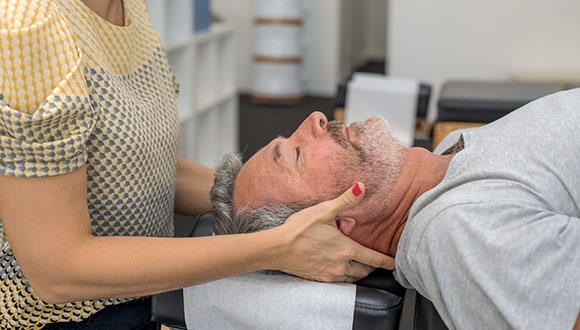Science-backed ways to get pain relief
Published July 2023 | 7 min read
Expert contributors Dr Chris Hayes, specialist pain medicine physician, board director at Pain Australia; Dr Joyce McSwan, Managing Director at PainWISE
Words by Katherine Chatfield
Everything you need to know about pain and all the options for relief.
Pain – we’ve all felt it, whether it’s a headache, back pain or a broken bone. Acute pain, which is usually the result of illness or an injury – like a bruise or a sprained ankle – eventually subsides, but for some of us, pain doesn’t go away.
One in five Aussies lives with ongoing, chronic pain, which can have a physical, mental, emotional and social impact on a person’s life. Research from the Australian Institute of Health and Welfare found that women are more affected by chronic pain than men, and those who have chronic pain are five
times more likely to be limited in their daily activities.
"There can be a lot of stigma around pain," says Dr Chris Hayes, specialist pain medicine physician and board director at Pain Australia. "It’s subjective as we can’t see other people’s pain. As a society, we need to validate pain. We also need to empower people in pain about what it means, and what methods of pain management are available to them."
Here are some important things to know about pain and some ways to get relief.
What is pain?
Pain can be a warning sign that something might be going wrong with your body. Your body contains sensory receptors called nociceptors that send messages to your brain when they detect something that’s potentially harmful. “In the first instance, pain is generally beneficial,” explains Dr Hayes. “It tells us to move our hand away from the flame or stop walking on a broken leg.”
Acute pain usually comes on quickly and lasts for a short period of time. Normally, when the cause of the pain, like an injury or infection, is treated or healed, the pain goes away.
Chronic pain is persistent pain that lasts for more than three months. There are many possible reasons for chronic pain. It can be due to the pain system becoming overprotective, trauma after an injury has healed or changes to the nervous system. “With chronic pain, your body can become ‘stuck’ in alert mode,” says Dr Hayes. “It can be a very complex situation that is a much slower fix in terms of treatment and management.”
Chronic pain isn’t just isolated to the area of your body that’s painful; it can affect your sleep, concentration, mental health and relationships. Of the people who live with chronic pain, in the past 12 months, 37% reported feeling depressed and 25% reported feeling anxious.
"Chronic pain can contribute to feeling depressed, being less physically active, selecting a poor diet or becoming more socially isolated," says Dr Hayes. He adds that this can be limiting in terms of getting treatment, so it’s worth looking at what you eat or whether you need support for your mental health, and if those things could help with the pain.
Here are some of the different types of pain relief and how they can be used:
Lifestyle-related pain relief
Pain relief doesn’t have to be over-the-counter medicine. "Sleep, exercise and nutrition are fundamental parts of what humans need to function," says Dr Joyce McSwan, managing director of PainWISE. "For example, pain can make it difficult to sleep, which means your central nervous system can be activated, making you anxious. This makes it even harder to sleep, making pain worse."
Learning skills to break these types of cycles is highly beneficial. "Active skills such as learning breathing exercises to calm your nervous system, or how to do basic exercises to settle your joints can go a long way to helping improve your lifestyle and manage some of your pain," she says.

Massage and pain relief
Massage can help with pain management to a certain degree, according to a recent study review.
You can get 100% back* on a first visit to a physio, chiro or osteo with over 16,000 extras providers in our No-Gap network, depending on your level of cover and annual limits. Find a participating provider with our search tool.
"Many people find relief from these methods," says Dr McSwan. She suggests having three or four treatments over four to six weeks, then evaluating if you’re functioning better than before. "If they’re working for you, and the cost is sustainable, then that’s great."
She adds: "These are passive modalities, though, which means you’re relying on someone or something else to help you manage your pain. It’s not advisable to only rely on that – you also need some active modalities in your pain toolkit [techniques which you do yourself, for example therapeutic exercise]."
Many people find heat or ice can help in pain management, even though the scientific research isn’t conclusive when it comes to consistent pain relief.
Cold therapy, including ice packs and ice baths, can reduce the risk of swelling and temporarily numb sore tissues to help with pain.
Heat therapy, including heat packs and hydrotherapy, can warm up and relax stiff joints or tissues and help with range of movement.
The right type of exercise has been shown to reduce pain perception, and also may increase serotonin levels which can help boost the mood if you’re suffering with chronic pain.

Medical pain relief
"Medical pain relief is usually a temporary fix," says Dr Hayes. "Only one in 20 people report that medication improves their chronic pain. Generally this is because pain medications become less effective the more you use them."
Medicines like over-the-counter ibuprofen and aspirin work by blocking the production of certain body chemicals that cause inflammation. Opioids, like codeine, tramadol and oxycodone, work by muffling your perception of pain, and boosting your feelings of pleasure.
"Medicine use has its place, but it has to be working well, with no limiting side effects," says Dr McSwan. "Look at your expectation of medication before you start taking it: are you expecting it to take all your pain away? Is it giving you significant functional improvement?"
For some conditions, surgery can be an option to reduce pain. "Joint problems and endometriosis can be dramatically helped by surgery," says Dr Hayes. "However, while surgery can get rid of chronic pain, it doesn’t always reverse all the factors that contribute to the pain."
Psychological strategies for pain management
"Cognitive behaviour therapy (CBT), mindfulness and meditation are proven, active strategies to help with pain relief," says Dr McSwan. "CBT is great for both acute and chronic pain, particularly if there’s been trauma involved."
CBT is a form of talking therapy that helps people develop skills to change negative thought patterns and behaviours. "It’s a great skill that you can use at any time, anywhere," says Dr McSwan. "Any of these mind-body techniques can help you restore a sense of control over your body. When we understand pain, it improves our ability to manage it."
Eligible HCF members can also get access to online cognitive behavioural therapy courses, delivered by This Way Up^.
How to cope with ongoing pain
See your GP as a first port of call. "Ask for a long appointment. It can be a good idea to keep a diary, noting down when and where you experience pain, and if anything triggers it," says Dr Hayes.
Dr McSwan adds: "Chronic pain really needs a multidisciplinary team and a proper pain program to help you manage it effectively. This can help you understand what’s happening and who you need to help you, and allow you to be taught the skills to manage your pain. When you’re surrounded by the right people, it can make all the difference."
How I deal with chronic pain
Jodie Humphries, 38, lives with rheumatoid arthritis. This inflammatory form of arthritis means her immune system attacks her healthy joints, causing pain and inflammation.
"I’ve been in chronic pain for two years. At first I assumed the pain in my hands and wrists was due to the bad set-up of my home office, but when it got so bad that I couldn’t move my hands, I went to the doctor. Most days I have pain in my wrist and the small joints of my hands. I can also have pain in my knees, ankles and toes.
"I started using over-the-counter anti-inflammatories, then my doctor gave me prescription anti-inflammatories, which help reduce the pain. I also use a hand and foot massager, a TENS [transcutaneous electrical nerve stimulation] machine, and compression clothing. I support my joints with braces, supports and kinesiology tape to help ease any possible pain. Warmth helps my pain, so I love a warm bath with Epsom salts, or a hot shower.
"My best advice to anyone who suffers from chronic pain is to listen to your body and don't push yourself. This can be hard, but it’s important to be open with the people around you as much as you feel comfortable."
Mental health support
To support eligible members with faster, easier access to qualified mental health professionals, you can book a free telehealth HealthyMinds Check-in with a PSYCH2U psychologist#.
Whether you’re looking for support for yourself or your loved ones, our unique range of mental health and wellbeing programs can help you understand and improve mental health challenges such as stress, anxiety and depression.
If you're struggling and need to speak to someone now, call Lifeline on 13 11 14.
Related articles
SIGNS OF DEPRESSION
While emotional ups and downs are normal, there’s a big difference between feeling sad and being depressed.
BREATHING FOR ANXIETY
When anxiety hits, it can be overwhelming. Use these relaxing techniques to curb stressful feelings.
IMPORTANT INFORMATION
* 100% back through More for You providers in our No-Gap network is available on selected covers. Waiting periods and annual limits apply. Providers are subject to change. We recommend that you confirm the provider prior to your appointment.
^ This service is not affiliated or associated with HCF in any way. You should make your own enquiries to determine whether this service is suitable for you. If you decide to use this service, it’ll be on the basis that HCF won’t be responsible, and you won’t hold HCF responsible, for any liability that may arise from that use.
# 1 HealthyMinds Check-in available per member per calendar year. Service is available free to all members with hospital cover. Excludes extras only cover, Ambulance Only, Accident Only Basic and Overseas Visitors Health Cover.
This communication contains information which is copyright to The Hospitals Contribution Fund of Australia Limited (HCF). It should not be copied, disclosed or distributed without the authority of HCF. Except as required by law, HCF does not represent, warrant and/or guarantee that this communication is free from errors, virus, interception or interference. All reasonable efforts have been taken to ensure the accuracy of material contained on this website. It’s not intended that this website be comprehensive or render advice. HCF members should rely on authoritative advice they seek from qualified practitioners in the health and medical fields as the information provided on this website is general information only and may not be suitable to individual circumstances or health needs. Please check with your health professional before making any dietary, medical or other health decisions as a result of reading this website.